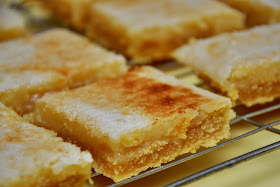Although beer is not my favourite alcoholic beverage, I was so tempted to try this legendary P.Hollywood's ultimate ploughman's loaf with rye, ale and oats. He says this is a historic British bread with modern twist. I had to do more twisting as I replaced ale with cider. My friend Catherine twisted the recipe even further by replacing rye with granary flour and ale with apple juice. The result of her bread looked stunning. :)
Though I couldn't taste it, I'm sure it tasted great as I trust her judgement.
Anyway, here is my "Rye, cider and oat bread" packed with flavour. I really enjoyed the nuttiness of rye, subtle sweetness of treacle and fruity flavour of cider. The crust gives a distinctive character to this bread.
This is a perfect loaf for a ploughman's lunch of chutney, apple and celery slices, and your favourite cheese.
I enjoyed this bread with camembert cheese and chillie jam. :)
For the loaf
- 350g (12oz) rye flour
- 150g (5½oz) strong white flour, plus extra for flouring
- 10g (¼oz) salt
- 10g (¼oz) instant yeast
- 50ml (2fl oz) black treacle
- approx 140ml (4¾fl oz) water (I used 120ml for my loaf)
- approx 250ml (9fl oz) cider (I used 220ml for my loaf)
- 150ml (5fl oz) cider
- 100g (3½oz) rye flour
- pinch of sugar
- handful of jumbo oats
Method
1.
Mix the flour, salt and yeast in a bowl. Add
the treacle, 100ml (3½fl oz) of the water and 150ml (5fl oz) of the cider. Using your
hands, stir the ingredients together until all the flour leaves the side of the
bowl. Gradually add the remaining cider and water if needed (I only added 20ml of water and 70ml of cider)- the dough should be
soft and all the sides of the bowl should be clean.
2.
Tip the dough onto a lightly floured surface
and knead for 5-10 minutes. The dough will be wet initially but will become
smooth once worked. When the dough has a smooth skin put it into a lightly
oiled bowl. Cover with a clean cloth and leave for two hours.
3.
For the topping, mix the cider with the rye flour
and a pinch of sugar to form a thick batter.
4.
Tip the dough out onto a floured surface and
shape into a ball. Spread the cider paste over the loaf and sprinkle over the
jumbo oats. Place the loaf onto a baking tray lined with parchment. Leave to prove
for one and a half hours.
5.
Preheat the oven to 220C (425F / Gas 7).










